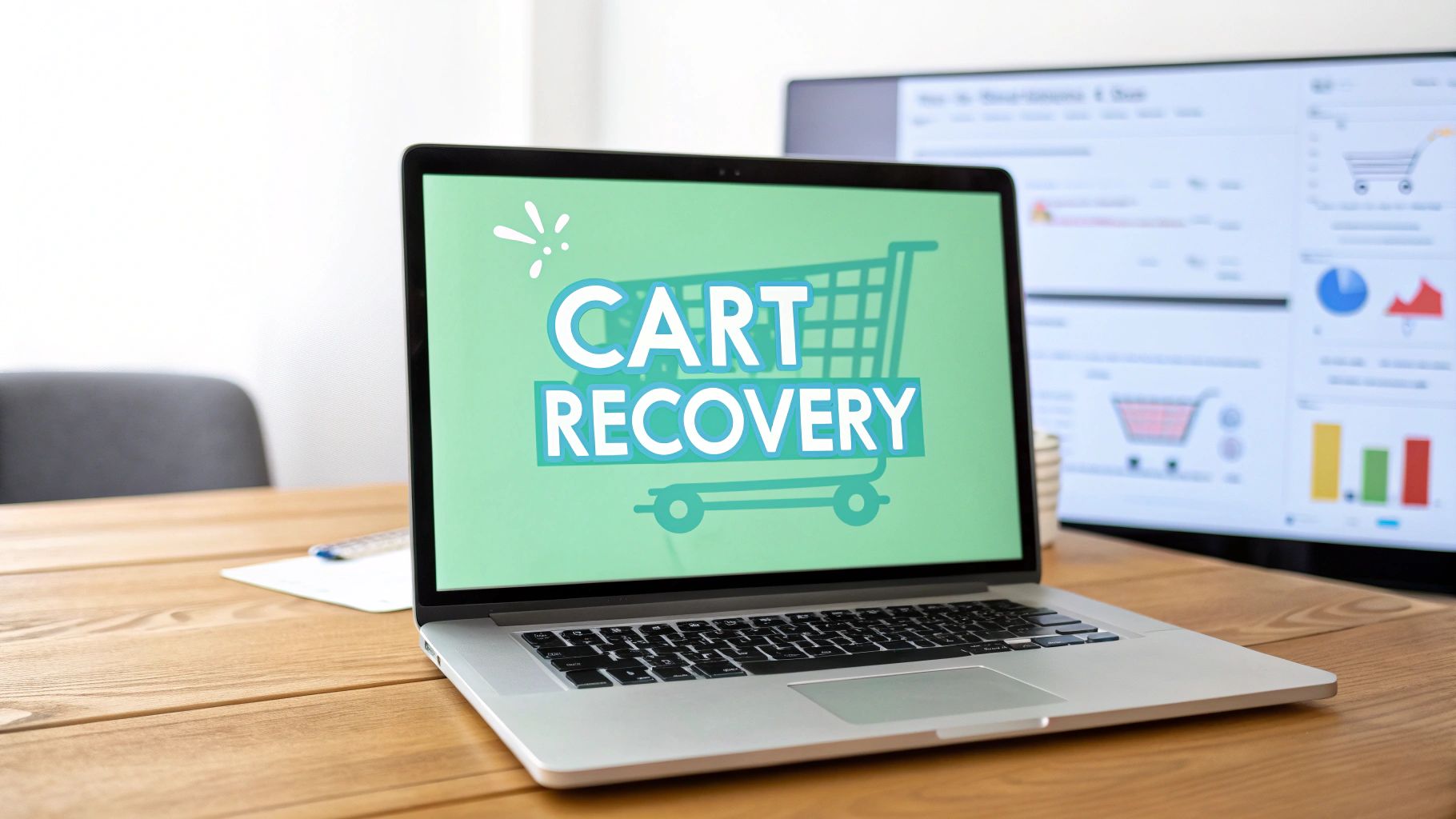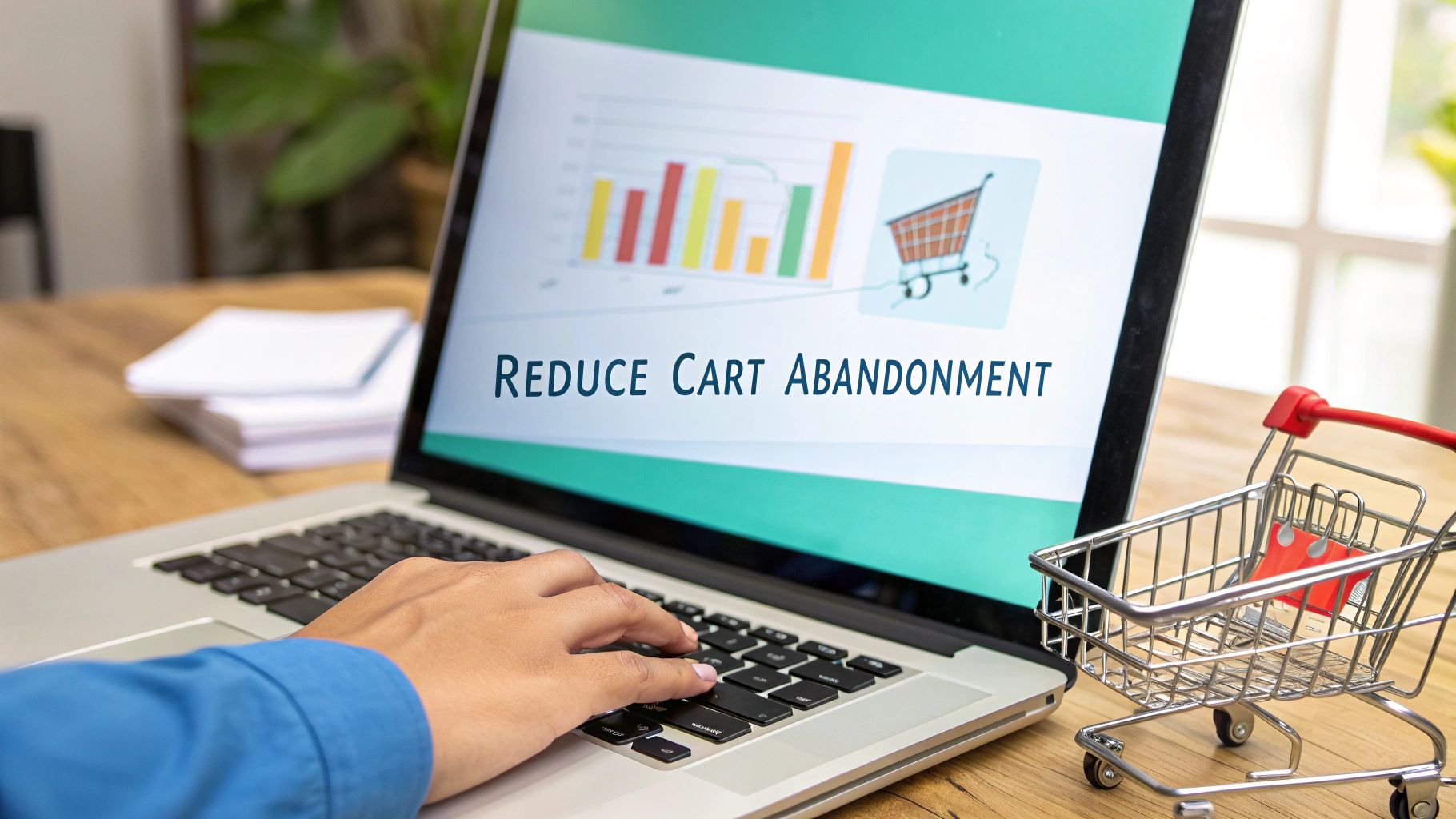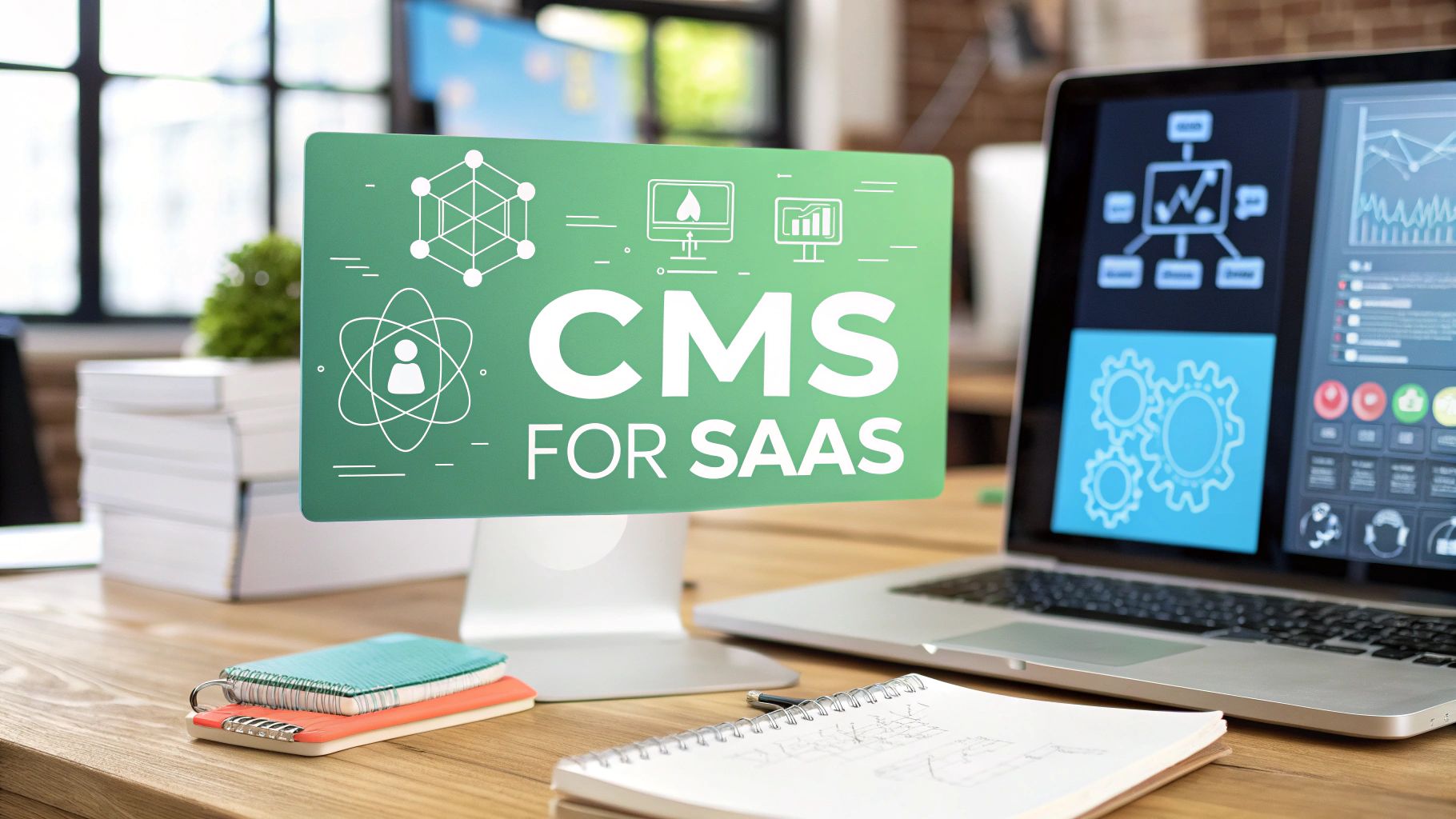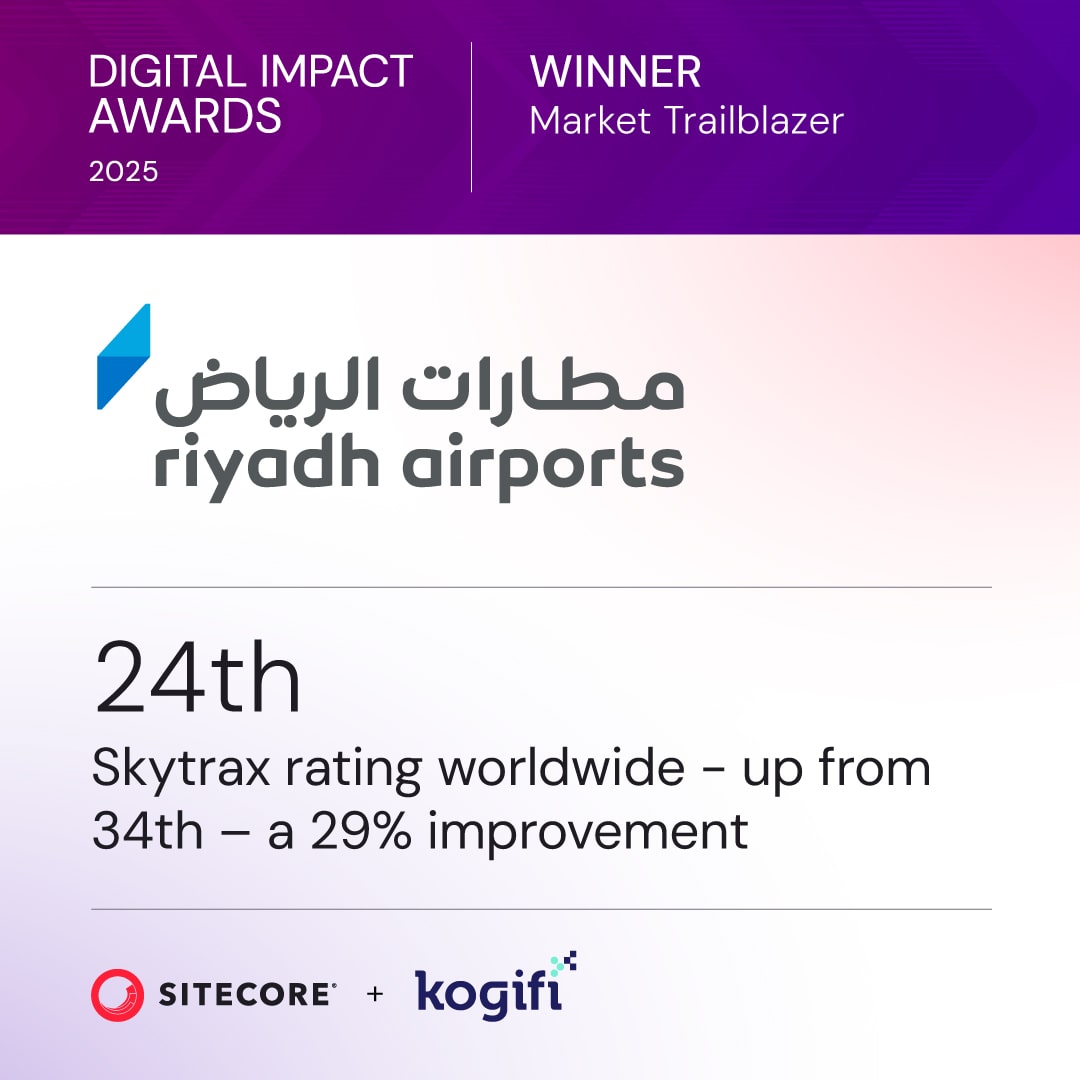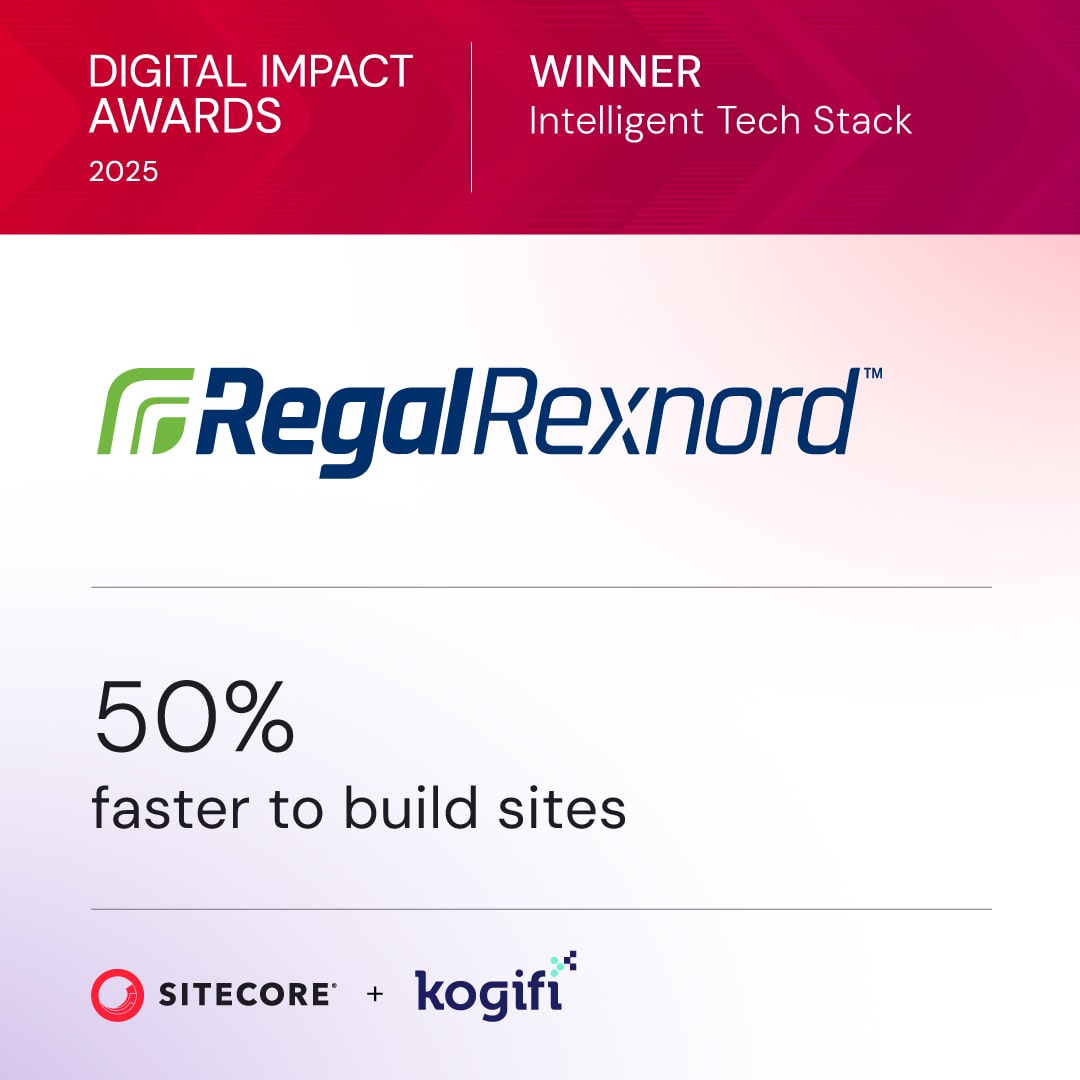To tackle shopping cart abandonment, you need to go beyond just noticing it happens. It's about digging into the why, streamlining the entire checkout journey, and bringing customers back with smart, personalized campaigns. For this, a powerful platform like Sitecore is key for mapping user journeys and finding those critical friction points, turning a frustrating experience into a smooth path to purchase.
Why Shoppers Really Abandon Carts and How to Fix It
Before you start changing buttons or rewriting copy, you have to understand why customers are leaving your specific site. Industry-wide stats are interesting, but they won't tell you about the unique snags in your checkout funnel. The real gold is in your own data, which helps build an evidence-backed diagnosis of the problem.
This is where a solid workflow comes in. Think of it as a three-part process: diagnose the issues with hard data, centralize your findings so everyone's on the same page, and then align your teams to take action.
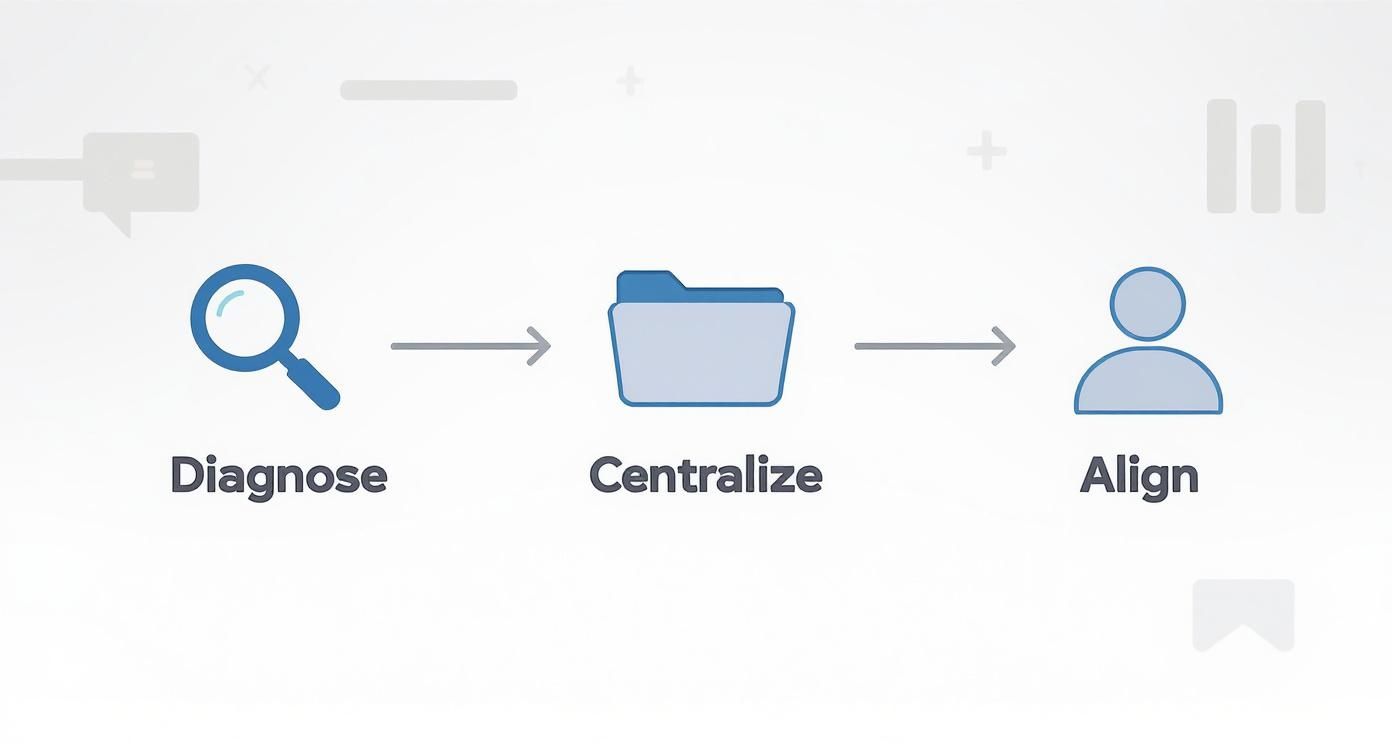
This isn't just about tech. It’s about making sure your technical solutions are grounded in solid data and a shared understanding across your entire organization.
Pinpointing Problems with Sitecore Analytics
Sitecore Analytics helps you move from guesswork to genuine insight. Instead of just knowing that users are dropping off, you can see exactly where and why. By tracing customer journeys, you can visualize the pages in your checkout process that are causing the biggest headaches.
Are people bailing on the shipping page? Or is the payment selection step the real problem? Sitecore lets you get granular by digging into metrics that scream user frustration, such as:
- Hesitation Metrics: You can see how long users hover over certain form fields, which is a classic sign of confusion or uncertainty.
- Rage Clicks: This feature flags areas where users are clicking repeatedly out of frustration, often pointing to a broken button or a confusing UX element.
- Form Field Errors: Track exactly which fields in your checkout form are causing the most errors. This highlights where you need clearer instructions or simpler inputs.
By segmenting your audience, you can uncover even deeper patterns. You might discover that mobile users from a specific country abandon their carts at a higher rate because you’re not offering a popular local payment method. These are the kinds of specific, actionable insights that lead to real fixes. A thorough approach to data analysis is a cornerstone of effective website conversion rate optimization, turning raw numbers into a clear strategic roadmap.
At its core, diagnosing cart abandonment isn't just about crunching numbers. It's about building a detailed picture of customer friction. Each data point tells a part of the story, revealing the moments where a smooth purchase journey breaks down.
Centralizing Findings for Team Alignment
Once you have this data, the next critical step is to get it out of its silo. A SharePoint intranet is a great central hub for these findings. By creating a dedicated space for e-commerce analytics, you can share dashboards, reports, and key takeaways with both marketing and development teams.
This shared knowledge base gets everyone on the same page. When the marketing team proposes a new discount and the UX team suggests a checkout redesign, both are working from the same data about customer friction points that you identified in Sitecore. This alignment is essential before you implement any platform-powered solutions, ensuring every change is targeted, purposeful, and has the best chance of succeeding. Once you know the reasons, you can start implementing practical tactics to reduce shopping cart abandonment and strengthen your sales funnel.
Make Your Checkout Effortless to Drive Sales
A clunky, confusing, or long checkout is one of the fastest ways to lose a sale. The moment a customer decides to buy, every extra step or unexpected field introduces friction. It gives them another chance to second-guess the whole thing. The real goal here is to make the final steps feel so natural that completing the order is the only logical next step.
When you transform your checkout from a frustrating hurdle into a smooth path to purchase, you're directly tackling one of the biggest drivers of lost revenue. It all comes down to cutting out unnecessary steps, being upfront about costs, and building a process that respects your customer's time.
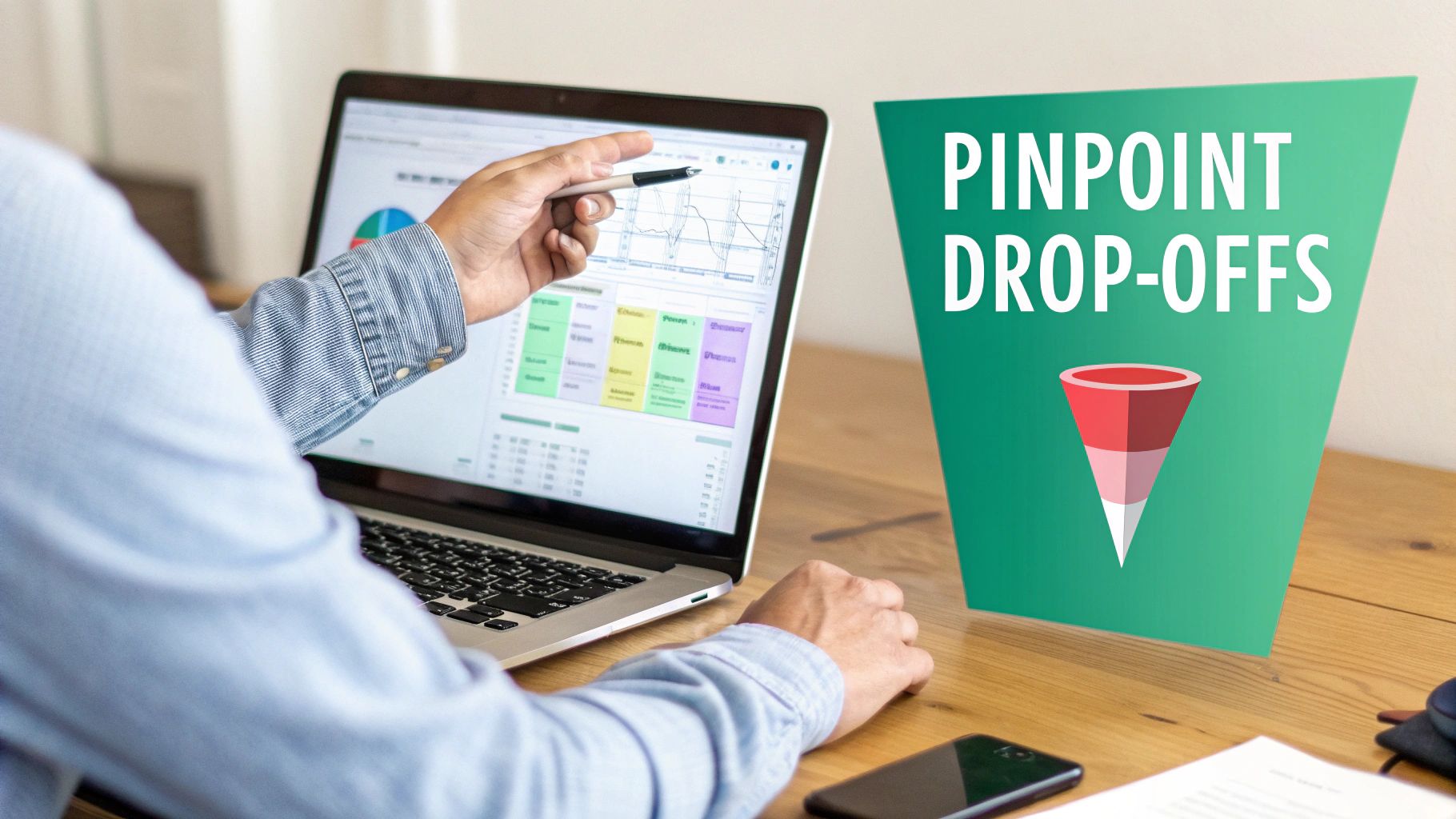
Remove Friction With a Headless Architecture
Modern e-commerce requires a level of flexibility that older, monolithic systems just can't deliver. This is where a headless commerce solution like Sitecore OrderCloud really becomes a powerful asset. By decoupling your front-end customer experience from the back-end commerce engine, you give your teams total control over the checkout flow.
This architectural freedom means you can design and A/B test incredibly streamlined experiences without being boxed in by rigid templates. You can experiment with different layouts, field setups, and even entirely different checkout models to see what converts best for your audience. For instance, you could test a multi-step wizard against a single-page checkout for mobile users—all powered by the same robust OrderCloud back end.
High-Impact Checkout Optimizations
To zero in on areas for improvement, start by simplifying the information you ask for. A focused effort to slash redundant form fields can significantly boost conversions.
Here’s a quick look at some of the most effective checkout improvements and the problems they solve, specifically with the Sitecore ecosystem in mind.
High-Impact Checkout Optimizations
By implementing these changes, you're not just improving usability; you’re demonstrating respect for the customer's time and making the final step of their journey a positive one.
A frictionless experience signals that your brand is efficient, modern, and customer-focused. That's how you build trust at the most critical moment of the transaction.
Here are a few more high-impact tactics to get you started:
- Enable Guest Checkout: Don't force users to create an account. It's a massive point of friction. Offer a guest option prominently, and give them a choice to create an account after the purchase is done.
- Integrate Social Logins: Make life easier by letting customers sign in with trusted providers like Google or Apple. One less password to remember.
- Use Progress Indicators: A simple visual progress bar helps manage expectations. It shows customers exactly where they are in the process and how many steps are left.
Achieve Transparency and Eliminate Surprises
Unexpected costs are the #1 reason shoppers abandon their carts. Nothing kills a sale faster than a surprise shipping fee or tax calculation on the final page. It’s absolutely critical to present a full cost breakdown as early and clearly as you can.
Use your checkout design to display all costs—subtotal, taxes, shipping, and any discounts—in a transparent summary. A great tactic is to make this summary a "sticky" element on the page, so it stays visible as the user scrolls and fills out their information.
For organizations managing complex product catalogs and customer data, a SharePoint-based solution can be used to centralize information about shipping rules, tax jurisdictions, and promo logic. Integrating this data source with Sitecore ensures that the cost calculations shown to the customer are always accurate, preventing those last-minute surprises. A full evaluation of your checkout is a key part of any thorough user experience audit checklist.
Build Trust and Offer Financial Flexibility
A slick checkout process gets customers to the finish line, but it’s trust that convinces them to cross it. If a shopper feels their financial information is at risk or they can’t find their preferred way to pay, they’re gone. Building credibility and offering payment flexibility are the final, critical pieces of the puzzle.
This isn't about just slapping a few badges on the page. It's about strategically removing any last-minute doubt or friction that could derail a sale.

Strategically Deploy Trust Signals
Trust signals are the visual reassurances that tell customers their data is safe and your business is legit. Think of them less as decorations and more as active conversion tools. The real trick is placing them exactly where anxiety peaks—like right before someone types in their credit card number.
If you’re running on a platform like Sitecore, you can get clever with personalization rules to show specific trust signals based on user behavior or location. For instance, a user who hesitates on the payment page could trigger a small tooltip highlighting your secure transaction guarantee.
Here are a few non-negotiable trust signals to consider:
- SSL Security Badges: Get those logos from trusted providers like Norton or McAfee right inside the payment section. It’s a universal sign of a secure connection that people instantly recognize.
- Clear Return Policies: Don't make people hunt for your return policy in the footer. A simple icon and a short, punchy summary like "30-Day Hassle-Free Returns" next to the "Complete Purchase" button works wonders.
- Prominent Customer Reviews: Use your CMS to pull in snippets of positive reviews or star ratings directly into the checkout flow. It’s a powerful reminder of the product’s value right at the moment of decision.
Trust isn't built with a single badge. It's the cumulative effect of demonstrating security, transparency, and legitimacy at every step of the checkout journey. Each signal chips away at customer anxiety, making the final purchase decision easier.
For teams using SharePoint, a document library can be a great central hub for all your approved trust assets—from security badge images to standardized return policy text. This ensures brand consistency across all your digital touchpoints managed through Sitecore, so every customer gets the same reassuring message.
Diversify Payment Options for a Global Audience
Forcing a customer to use a payment method they don't like is an instant—and completely preventable—deal-breaker. In a global market, just offering traditional credit cards won't cut it anymore. Digital wallets, regional payment systems, and "Buy Now, Pay Later" (BNPL) services aren't just nice-to-haves; they're essential.
It’s been shown that a significant percentage of shoppers will likely abandon their cart if they don't see a variety of payment options. This is especially true for international customers with different financial habits. Offering at least three distinct payment methods can seriously lower your abandonment rate. You can find more insights on how payment options affect cart abandonment on analyzify.com.
This is where a composable platform like Sitecore Commerce really shines. Its architecture is built for seamless integration with tons of third-party payment gateways. That means you can easily connect to global leaders like PayPal and Stripe, popular digital wallets like Apple Pay and Google Pay, and crucial region-specific providers.
For example, if you're expanding into the Netherlands, integrating iDEAL is a must. Selling in Germany? Offering Sofort or Giropay is critical. Sitecore's flexible framework makes adding these gateways a straightforward task for developers. This adaptability is key to creating a checkout experience that feels local and trustworthy to every single customer, no matter where they are.
Use Personalization to Prevent Abandonment
Why wait for shoppers to abandon their carts when you can stop them before they even think about leaving? A reactive strategy, like sending recovery emails, is a must-have. But a proactive one? That’s where the real power lies. Real-time personalization is your best bet for keeping shoppers engaged, answering their questions before they ask, and guiding them smoothly toward checkout.
This is exactly where the Sitecore product portfolio shines. By connecting behavioral data with a powerful decisioning engine, you can deliver targeted interventions the moment a user shows signs of hesitation.
Leverage Sitecore Personalize and CDP
Sitecore's composable DXP brings a formidable one-two punch to tackle cart abandonment head-on. Think of Sitecore CDP (Customer Data Platform) as your central nervous system; it collects and unifies customer data from every single touchpoint into a single, cohesive profile. It tracks everything from past purchases and browsing history to what a user is doing on your site right now.
This rich, unified data is the fuel for Sitecore Personalize, an advanced decisioning and experimentation engine. It lets you build and launch sophisticated personalization rules based on all the insights gathered by the CDP. This combination allows you to move beyond generic pop-ups and create experiences that feel genuinely helpful and relevant to each individual shopper.
The goal here is to anticipate friction and smooth it over before it ever leads to an abandoned cart. You can dive deeper into creating these kinds of experiences in our complete guide to the personalization of a website.
Implement Real-Time Interventions
With a solid data foundation in place, you can start rolling out specific, high-impact personalization tactics. These aren't just random offers; they are strategic responses to specific behaviors that signal a user might be about to leave.
Here are a few practical examples you can build using Sitecore:
- Exit-Intent Offers: When Sitecore Personalize detects a user’s cursor moving toward the browser’s close button—a classic sign of exit intent—you can trigger a targeted overlay. Forget the generic "Don't Go!" message. Instead, dynamically show the items in their cart with a unique, single-use discount code like, "Complete your order now for 10% off."
- Shipping Threshold Nudges: High shipping costs are a notorious conversion killer. You can create a rule that triggers a banner when a user's cart is getting close to your free shipping threshold. A simple message like, "You're only $10 away from free shipping!" is a powerful motivator to add one more item instead of ditching the entire purchase.
- Dynamic Scarcity and Urgency: If someone is looking at a product with low stock, you can display a real-time message like, "Only 3 left in stock – order soon!" This creates a natural sense of urgency that encourages immediate action. For items already in the cart, a simple reminder like, "Items in your cart are not reserved" can do the trick.
Personalization is most effective when it solves a problem for the customer. It shouldn't feel like a marketing trick, but rather a helpful assistant that removes obstacles and makes the buying process easier.
Building Your Personalization Framework
To put these strategies into play effectively, you need a clear framework. Start by digging into your analytics to identify common abandonment triggers, then map them to specific personalization rules you can build within Sitecore.
For organizations that also use SharePoint, a knowledge management site can be an excellent place to store your personalization strategy. You can document your rules, define user segments, and keep creative assets organized. This creates a centralized playbook that ensures your marketing and e-commerce teams are aligned on the tactics being deployed through Sitecore, which makes it much easier to measure the impact of your efforts on reducing cart abandonment.
Weave a Multi-Channel Cart Recovery Plan
Look, even with a flawless site, life happens. Distractions pull shoppers away, and some will always leave items behind. That’s where a smart recovery strategy comes in—it’s your safety net for turning a nearly-lost opportunity into a sale. This isn't about sending one generic email; it's about building an automated, multi-channel campaign that genuinely helps.
With the right setup, you can create a flow that feels timely and helpful, not intrusive, guiding customers back to finish what they started, no matter what device they’re on.

Design a Sophisticated Recovery Sequence with Sitecore
A one-size-fits-all approach to cart recovery just doesn’t cut it anymore. What works is a carefully timed sequence of messages delivered across the right channels. This is exactly what Sitecore’s marketing automation tools are built for—crafting intelligent, responsive workflows.
You can design a plan that listens for abandonment triggers and then automatically rolls out a personalized sequence. This shifts your efforts from a simple, forgettable reminder to a structured conversation designed to gently nudge the customer back.
A proven recovery sequence often looks something like this:
- 1 Hour After Abandonment: Send a friendly, low-pressure email. The goal is simple recall. A subject line like "Did you forget something?" works well. The key is to dynamically pull in the exact items left in the cart, making it a one-click return.
- 24 Hours After Abandonment: If that first email didn't do the trick, the follow-up can introduce a soft incentive. Something like, "Still thinking it over? Here's 10% off to help you decide," can be incredibly effective without cheapening your brand.
- 72 Hours After Abandonment: This is your final touchpoint. You can create a little urgency with a message like, "Your items are selling out! Complete your order before they're gone," or maybe present a slightly better offer, especially for high-value carts.
Personalize Messaging Based on Cart Contents
The real magic of a platform like Sitecore is the ability to personalize every single message. Forget the generic "You left items in your cart" email. Instead, you can tailor the content based on the exact products the shopper was looking at.
For instance, if a customer abandoned a cart with a specific camera model, your recovery email can be so much more powerful. You could include:
- A direct link right back to that product page.
- A few glowing customer reviews or testimonials for that camera.
- Links to useful accessories, like lenses or tripods.
This level of personalization shows you’re paying attention. It provides real value and transforms a simple reminder into something more like a helpful shopping assistant. To get this right, you'll want to explore platforms with powerful email marketing features like automation, personalization, and robust A/B testing.
The most effective recovery campaigns don't feel like marketing at all. They feel like good customer service—a timely, relevant reminder that helps a customer complete a task they already intended to finish.
This is also the perfect opportunity to test what works. You can learn more about how to create an A/B testing email campaign in Sitecore Send in 9 steps and see which messages, subject lines, and offers truly connect with your audience. For teams using SharePoint, setting up a central repository for email templates and performance data keeps everyone aligned on what's driving results.
Expand Beyond Email with SMS and Retargeting
Email is the cornerstone of any recovery plan, but a true multi-channel approach meets customers wherever they are. Mobile devices drive a huge chunk of online shopping, but they also have the highest cart abandonment rates. This makes mobile-first channels absolutely essential.
Here’s how to extend your reach:
- SMS Reminders: For customers who have opted in, a simple text message about 24 hours after abandonment can be a game-changer. A short, direct message like, "Hi [Name], you left items in your cart at [Your Store]. Here's a link to complete your purchase: [link]" cuts straight through the noise.
- Targeted Social Ads: For high-value carts, it's worth putting a little budget into retargeting. You can use data from Sitecore CDP to build a specific audience segment of users who abandoned carts over a certain dollar amount. Then, show them dynamic ads on Facebook or Instagram featuring the exact products they left behind.
By orchestrating all these touchpoints within Sitecore's automation engine, you create a cohesive, respectful customer journey. This dramatically increases your chances of winning back what would have otherwise been a lost sale.
Your Questions on Cart Abandonment Answered
Digging into cart abandonment always brings up a few key questions. Here’s a quick-reference guide to tackle the most common ones, with practical answers straight from our experience in the Sitecore ecosystem.
What Is a Good Cart Abandonment Rate to Aim For?
Everyone wants to know the magic number, but the truth is, a "good" rate really depends on your industry. While the global average sits stubbornly around 70%, most e-commerce sites should be aiming for something between 60-65%. If you can get below 60%, you're doing exceptionally well.
But don't get hung up on chasing a universal average. The most important metric is your own. Start with your current abandonment rate as the benchmark. From there, your goal should be a consistent 5-10% reduction through the kinds of optimizations we've been talking about. That kind of steady, internal improvement is far more valuable than trying to match an arbitrary number.
How Does Sitecore Personalize Create Effective Exit-Intent Popups?
This is where things get really clever. Sitecore Personalize is so effective because it watches user behavior in real time. It can actually detect the moment a user’s cursor starts drifting towards the browser’s close button or a new tab—a dead giveaway they're about to leave.
At that exact second, it triggers a personalized web experience, like a popup. This isn't just some generic ad. It’s a dynamic, last-ditch effort to keep them on the page. It can show them the items in their cart, address them by name, or flash a unique, time-sensitive offer like, "Complete your purchase in the next 10 minutes for free shipping." It’s a powerful way to pull their attention back and save a sale that was literally seconds from being lost.
The secret to a successful exit-intent strategy is relevance. Sitecore's ability to use real-time behavioral data ensures the offer is a compelling, personalized reason to stay, not just another generic interruption.
How Quickly Should the First Abandoned Cart Email Be Sent?
Timing is everything here. The sweet spot for that first recovery email is within one hour of the cart being abandoned. During that window, the customer’s intent to buy is still warm, and the products are fresh in their mind. Any sooner, and you risk seeming pushy; wait a full 24 hours, and you’ve given them plenty of time to lose interest or, worse, buy from a competitor.
We’ve seen a simple, three-part sequence work wonders, and it's easy to set up using Sitecore's marketing automation tools:
- Email 1 (The Gentle Nudge): Sent at the 1-hour mark. This is just a friendly reminder of the great items they left behind.
- Email 2 (The Incentive): Sent after 24 hours. This one often includes a small discount or creates a little urgency with a "low stock" warning.
- Email 3 (The Last Chance): Sent at 72 hours. This is the final push to bring them back and close the deal.
For teams managing their marketing assets in SharePoint, it’s a great idea to build a library of pre-approved email templates for this sequence. It keeps everything on-brand and makes it incredibly fast to launch and test new recovery campaigns.
At Kogifi, we specialize in implementing and optimizing Digital Experience Platforms like Sitecore to solve critical e-commerce challenges like cart abandonment. Our expert teams can help you diagnose issues, implement personalized recovery strategies, and drive higher conversions. Visit https://www.kogifi.com to learn how we can transform your digital presence.






















